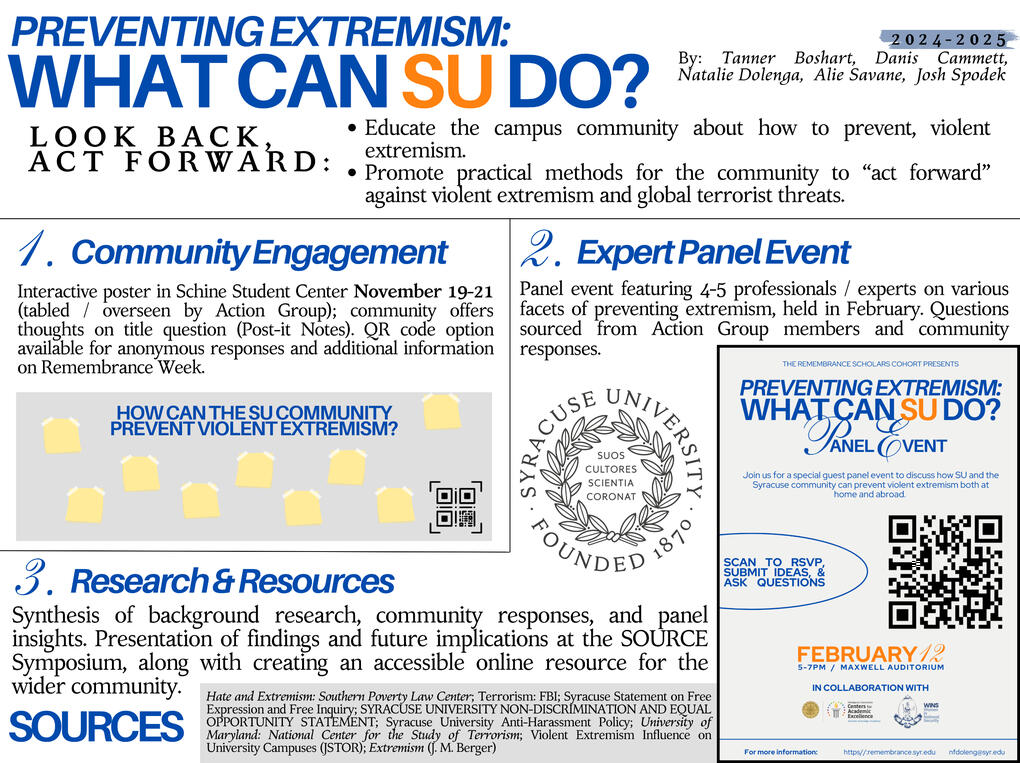Preventing Violent Extremism: What Can SU Do?
RSVP for our panel event and ask questions here

Defining and Understanding Extremism
For the purposes of this project, and to promote an inclusive exploration and understanding of this topic, we define extremism as the following:“An in-group’s success/survival that can not be separated from the need for hostile action against an out-group.” (Berger, 2018, p. 44).Grounded in Henri Tajfel and John L. Turner’s “Social Identity Theory,” extremism is a belief system that identity groups employ to recruit eligible in-group members, to spread their messaging and rhetoric, and to rationalize violent actions taken against members of an out-group. Extremist ideologies vary across contexts and are typically linked to a single social identity (or overlapping identities): race, ethnicity, religion, nationalism, anti-government, anarchism, classism, single-issue movements, and gender/sexual identity.Although modern-day extremist movements are traditionally associated with a social identity, historical research argues that these beliefs are “...not the exclusive province of any single race, religion, or nation” (Berger, 2018, p. 3). Rather, extremism is a circular, fluid phenomenon, defined relative to the “center” or “norms” of any given society (Berger, 2018, p. 1). Thus, extremism develops relative to an individual group’s understanding of their social position, and may transform into an extremist movement once the group mobilizes around an “identity narrative” that explains their lived experiences and justifies violent action to change them.As with other societal issues, extremism has only grown into a more complex issue over time, especially with advancements in communication technologies in the 21st century. Unlike any other time in human history, the internet and social media platforms provide extremist movements with a convenient and persuasive means to recruit eligible in-group members and spread their ideologies across borders and oceans at a rapid pace. Living in the “information age,” one is constantly exposed to new insights and perspectives. However, without guidance on how to interpret and make sense of this information, it is easy for one to become overwhelmed or uncertain about their place in society. Extremist movements capitalize on this uncertainty, and often disseminate their ideological narratives online to grow their membership and persuade others to take action on their behalf on a global scale (Berger, 2018, p. 154). With these considerations in mind, this project aims to recognize the dynamic nature of extremist movements and to engage in meaningful discourse on how to best counter violent extremism in our present context and in the future.While we acknowledge the existence of specific extremist movements and ideologies, this project does not aim to provide a platform to express or promote those ideas. The goal is ultimately to foster conversation and provide a medium by which the campus community can mutually educate one another about the social and political factors that contribute to the formation of these ideas. In cultivating ways to uniformly define and address extremism, we, as a collective University community, can work together to foster understanding and acceptance of diverse perspectives across our campus and beyond.
Terrorism vs. Extremism
Terrorism: Violent tactics often used by extremist groups to achieve their political or ideological goals. Not all acts of violence are inherently extremist (Berger, 2018, p. 28); for example, state militaries and defense forces are tasked with defending their nations against foreign threats, which often involves the use of violence and/or force.Extremism: A belief system that often relies on hostile actions (i.e., terrorist attacks) to carry out a group’s intentions.
Berger, J. M. (John M.). Extremism. Cambridge, Massachusetts: The MIT Press, 2018.
Tajfel, H., & Turner, J. C. (1978). Intergroup behavior. Introducing social psychology, 401(466), 149-178.
Resources
Anti-Defamation League Syracuse University Report CardAssessing the Effectiveness of Programs to Prevent and Counter Violent ExtremismCenter for Prevention Programs and Partnerships: Department of Homeland SecurityCountering Violent Extremism: FBI and DHS need helpDeveloping Effective Frameworks for CVE-Hedayah_ICCT Report.pdfExtremism (2018) - J.M. BergerGeorgetown Institute of Women, Peace and Security (GIWPS): Countering Violent ExtremismHate and Extremism: Southern Poverty Law CenterJ.M. Berger - The Toxic Mix of Social Media and Extremism (2016)Peter Bryne - “Anatomy of Terror: What Makes Normal People Become Extremists?”Terrorism: FBIThe Prevention Project: Syracuse UniversityUniversity of Maryland: National Center for the Study of TerrorismUSIP work on Violent ExtremismViolent Extremism Influence on University Campuses, JSTOR
Our Project


Act Forward Symposium, 10/24/24
